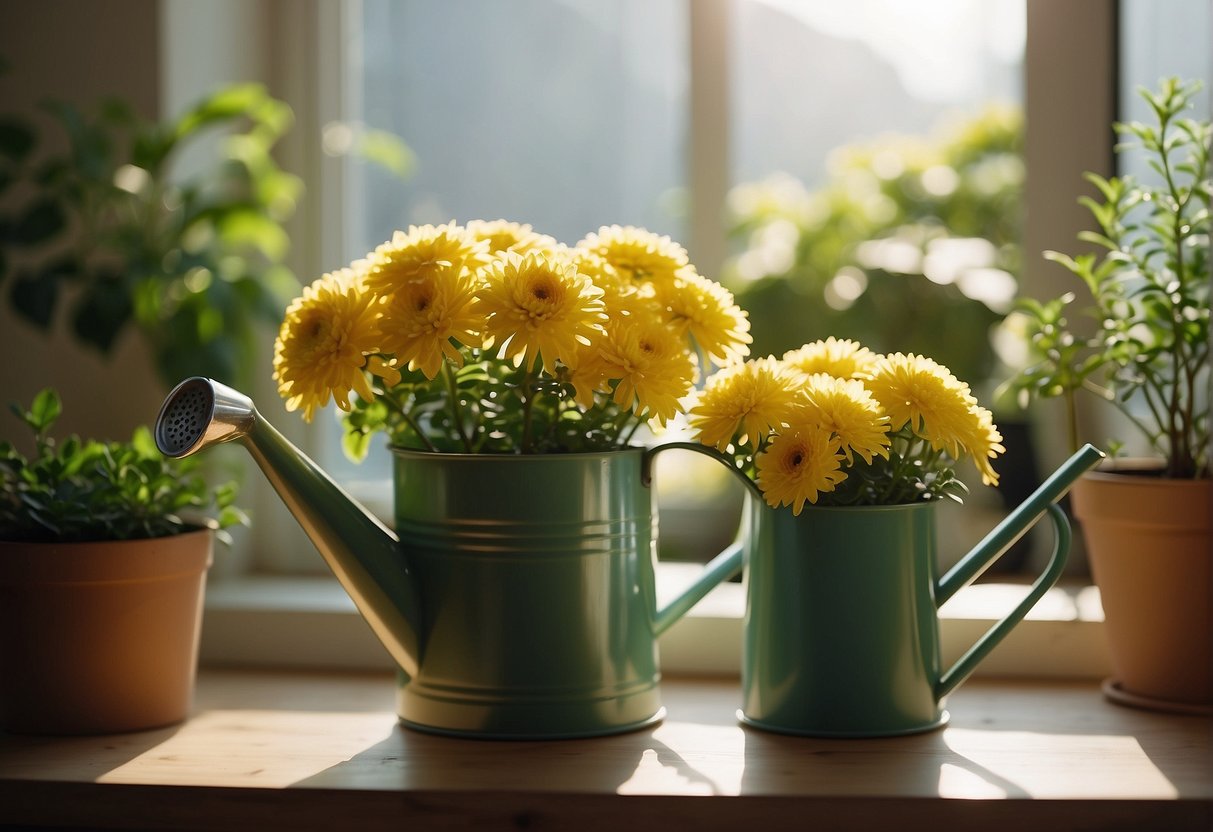Chrysanthemums, commonly known as “mums,” are a popular fall flower that bring vibrant color to the garden when many other plants are starting to fade. As a perennial, mums can provide years of beauty, but to do so, they require certain care to keep them alive and thriving. My personal experience with these flowers has taught me that understanding their basic needs is key to enjoying their blooms season after season.

In my garden, I make sure my mums have well-draining soil and ample sunlight, since this is critical for their health and vitality. They are not particularly fussy plants but paying attention to watering, proper fertilization, and occasional pruning can make a significant difference in their performance. The satisfaction of seeing these hardy plants return each year is a testament to the care invested in them.
Regular maintenance such as deadheading spent flowers and dividing the plants every few years also promotes robust growth and flowering. I’ve found that mums are more than just a symbol of autumn; they can become a mainstay of the garden landscape, with a little effort and know-how. By establishing a routine of essential care, mums will reward gardeners with their delightful blooms and hardy nature through many seasons.
JUMP TO TOPIC
Caring for Garden Mums
Garden mums, with their vibrant blooms, are autumn standouts that I find essential for a colorful garden. Their care involves proper planting, consistent watering, timely feeding, and regular maintenance.
Planting and Soil Requirements
🌱 Key to successful mums: well-drained soil and ample sun.
For garden mums to thrive, they need a spot that receives full sun for at least half of the day. They prefer well-drained soil to prevent root rot. I ensure to amend the garden beds with compost and a high-quality potting mix, aiming for a soil pH around 6.5. Raised beds can provide excellent drainage if the garden soil is too compact.
| Planting Step | Importance |
|---|---|
| Full Sun Location | Encourages robust growth and abundant blooms |
| Soil Amendment | Improves soil structure and nutrient content |
Watering and Feeding
Mums require even moisture, so I water them deeply whenever the top inch of soil feels dry. Overwatering should be avoided to prevent disease.
Fertilizer application is crucial for mums. I feed them with a balanced flower and vegetable water-soluble plant food, following label instructions, to promote strong stems and vibrant flowers, typically ceasing fertilization by late summer to prepare the plants for dormancy.
Pruning and Maintenance
Regular maintenance keeps garden mums looking their best and encourages continued flowering. I pinch back the growing tips periodically until early July to create bushier plants with more blooms. Deadheading spent blooms is also a routine to encourage additional blooming.
Avoid cutting back old stems and foliage before winter, as they help protect the root ball from freezing temperatures.
Before the onset of winter, I apply a thick layer of mulch around the base to insulate the soil, offering an extra layer of protection and helping the mums survive the cold. It’s essential to clear away the mulch in the spring to allow new growth to emerge.
Seasonal Considerations for Chrysanthemums
In caring for chrysanthemums, understanding the unique needs each season brings ensures the vibrant display and health of these plants. Through careful attention to watering, light exposure, and temperature, I keep my mums thriving year-round.
Spring and Summer Growth
During spring, I ensure my mums are planted in containers with well-draining soil, avoiding the risk of root rot. I find that ample sunlight is imperative for robust growth, so I position them to receive full sun, which translates to at least six hours of direct sunlight each day.
🌷 Watering: Consistent moisture is key. Mums’ soil should remain moist but never saturated.
🌱 Fertilizer: I apply a water-soluble fertilizer designed for flowers and vegetables, adhering to label instructions.
🔆 Light: Placing mums in full sun encourages vigorous growth and prepares them for the autumn blooming.
Autumn Blooming and Display
I always look forward to the explosion of fall color as my mums bloom. To get the most out of their displays, I monitor the moisture levels closely, watering them as necessary to prevent wilting.
🍁 Timing: Mums should be well-established before the onset of fall to ensure a full bloom.
✂️ Pruning: Once flowering commences, I remove spent blooms to encourage further flowering and maintain a tidy appearance.
Winterizing for Cold Weather
As temperatures drop, it’s crucial to prepare mums for overwintering. Proper winterizatilon can result in a hardier plant ready for spring revival.
I cease fertilization as fall ends to avoid new growth that can’t survive the frost. Once the first frost hits, I cut back the stems to just above the soil line, then insulate with mulch for protection against freeze-thaw cycles that can heave roots from the ground.
Types of Mums
Chrysanthemums, or ‘mums’ for short, are popular perennials cherished for their vibrant blossoms that signal the arrival of fall. Knowing the differences between the varieties is crucial for successful cultivation and care.
Garden Mums vs. Florist Mums
Garden mums, also known as hardy mums, are bred to withstand outdoor conditions and can endure winter climates if properly prepared in the fall. They make excellent additions to a fall garden alongside pumpkins and other autumnal decor. On the other hand, florist mums are generally grown as indoor potted plants and are considered less hardy, often treated as annuals because they may not survive colder temperatures outdoors.
Florist mums: Often grown indoors, usually not winter-hardy.
Variety in Colors and Shapes
Mums offer a wide range of colors, including vibrant yellows, oranges, bronzes, and reds, with each hue complementing autumn’s palette perfectly. The diversity doesn’t stop at color; mums are also available in a variety of shapes and sizes, with some cultivars boasting daisy-like petals, while others have globular blooms. These different forms make mums versatile for both garden landscapes and floral arrangements. My personal experience has taught me that these diverse characteristics allow for creative freedom in garden design, particularly when mums are paired with other seasonal plants.
Mum Shapes: Daisy-like petals to globular blooms
Understanding these distinctions and characteristics of mums is essential for selecting the right type for your garden or home and ensuring that your mums thrive season after season.
Preventing Common Chrysanthemum Problems
To keep mums alive and flourishing, I focus on proactive measures against diseases, pests, and environmental stressors. Here’s how I manage these challenges effectively.
Managing Diseases and Pests
I ensure good air circulation around my mums to prevent fungal diseases. Regularly inspecting the plants for pests and diseases, I treat any issues early with appropriate fungicides or insecticides. Keeping the foliage dry and watering at the base of the plant are crucial steps I follow to deter disease.
A balanced soil mix with proper drainage reduces the risk of root rot and other water-related diseases.
Overcoming Environmental Stress
I protect my mums from environmental stressors like extreme temperatures and inadequate sunlight. Adequate sun is crucial for health and flowering, so I ensure they receive at least 6 hours of direct sunlight daily. During harsh weather, I mulch the base to insulate the root ball from frost and spring frosts, and I make sure the soil has good drainage to prevent waterlogging, which can lead to wilting or root issues.
- Ample Sunlight: At least 6 hours of direct sunlight daily.
- Mulching: A layer of mulch around the base for temperature control.
- Good Drainage: Well-draining soil to prevent overwatering.












